
A palm oil company remains at the heart of conflict in northern Guatemala, months after a mass fish die-off. A day after company operations were suspended pending further investigation into the incident, three community leaders were abducted and threatened by company workers and an outspoken local teacher was murdered by unidentified assailants in broad daylight.
On September 17, a criminal court judge ordered the suspension of Reforestadora de Palmas del Petén, S.A. (REPSA) operations in the municipality of Sayaxché, in the Petén department. The company is allegedly responsible for an ecological disaster in June, when aquatic life turned up dead along a 100-mile stretch of the La Pasión River. The suspension is to facilitate a judicial investigation into whether REPSA was responsible for the die off. Judge Karla Hernández also authorized the Office of the Public Prosecutor – Guatemala’s public agency responsible for all criminal prosecution – to carry out search and seizure operations of company property deemed necessary to the investigation.
REPSA is part of Guatemala’s largest palm oil producer, the Grupo Olmeca conglomerate. The company controls at least a third of the country’s 130,000 hectares of oil palm plantations and exports its products to other Central American and Caribbean nations. REPSA did not respond to Mongabay’s request for comment by the time of publication.
Early in the morning following the court order suspending REPSA operations in Sayaxché, three human rights activists were illegally detained by REPSA workers who were staging a demonstration at the time to protest the judge’s decision that put them out of work. Hermelindo Asig, Manuel Mendoza, and Lorenzo Pérez were abducted from their vehicle near a REPSA processing plant while on their way to a meeting in a neighboring department. They were restrained, confined in a covered truck, and threatened with being burned alive before their release late that afternoon, according to statements by the victims and human rights organizations.
Asij and Mendoza are members of the National Council of the Displaced of Guatemala (CONDEG), and Pérez is the organization’s coordinator. The three men have also been involved with the Commission for the Defense of Life and Nature, which was formed in Sayaxché in the wake of the mass fish die-off in June. CONDEG and the commission have been at the forefront of local organizing to seek answers, manage impacts, and demand justice for the ecological disaster in the La Pasión River. Asig, Mendoza, and Perez were told by their abductors that they were being held as a result of their supposed involvement in the suspension of company operations, according to Front Line Defenders, a Dublin-based human rights organization.
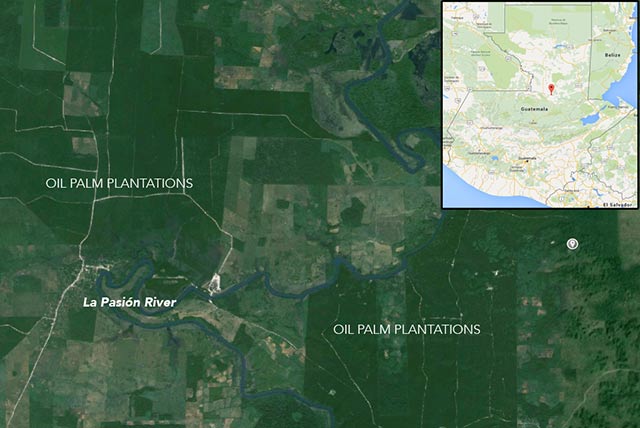 Google Earth image showing locations of oil palm plantations along the La Pasión River in Guatemala. Image credit: Mongabay. (Background image courtesy of Google Earth).
Google Earth image showing locations of oil palm plantations along the La Pasión River in Guatemala. Image credit: Mongabay. (Background image courtesy of Google Earth).
While Asij, Mendoza, and Pérez were still being illegally detained on September 18, Rigoberto Lima Choc was fatally shot in broad daylight in Sayaxché, in front of the building housing the local justice of the peace court in the center of town. Two unidentified suspects were seen fleeing the scene on a motorcycle.
Lima Choc was a 28-year-old primary school teacher who lived and taught in the village of Champerico, in the municipality of Sayaxché. Twelve days before his murder, Lima Choc was elected to form part of the local government in Sayaxché and would have become a municipal councillor in January. He was also one of the first people to speak out nationally about the ecological disaster on the La Pasión River and to formally denounce REPSA.
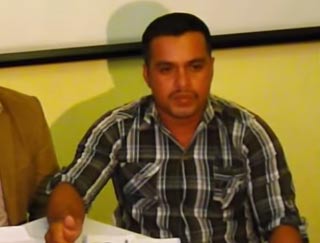 Teacher and municipal councilor-elect Rigoberto Lima Choc denounces the mass fish die-off on the La Pasión River at a press conference on June 17. He was fatally shot September 18. (Video still courtesy of Marcha Indígena/YouTube)“We don’t want this to remain in impunity,” Lima Choc said at a June 17 press conference in Guatemala City, where he highlighted the impacts on the local fishermen and communities that depend on the La Pasión River. “We’re going to continue to struggle for the formal complaints we have already filed, and continue to file formal complaints until we see where it takes us.”
Teacher and municipal councilor-elect Rigoberto Lima Choc denounces the mass fish die-off on the La Pasión River at a press conference on June 17. He was fatally shot September 18. (Video still courtesy of Marcha Indígena/YouTube)“We don’t want this to remain in impunity,” Lima Choc said at a June 17 press conference in Guatemala City, where he highlighted the impacts on the local fishermen and communities that depend on the La Pasión River. “We’re going to continue to struggle for the formal complaints we have already filed, and continue to file formal complaints until we see where it takes us.”
Lima Choc also called on government officials to prevent the kinds of incidents that took place three months later, on the day of his murder. “What we would also like is to ask authorities to prevent the persecution of community leaders, who are just trying to help the people,” he said.
Lima Choc’s murder is under investigation, but many community and human rights activists believe he was killed in retaliation for the suspension of REPSA’s operations because he had spoken out. Even a Guatemalan government agency made the connection. In a September 22 statement condemning Lima Choc’s murder, the National Protected Areas Commission (CONAP) noted that “the deplorable incident that took place was apparently a consequence of the struggle to elucidate the ecocide that occurred in the La Pasión River.”
“Ecocide”on the La Pasión River
The massive loss of aquatic life in the La Pasión River had previously been referred to as “ecocide” by the Ministry of the Environment and Natural Resources (MARN) in a June 10 statement deeming the disaster to be “the most serious environmental problem of its kind in national territory in living memory.”
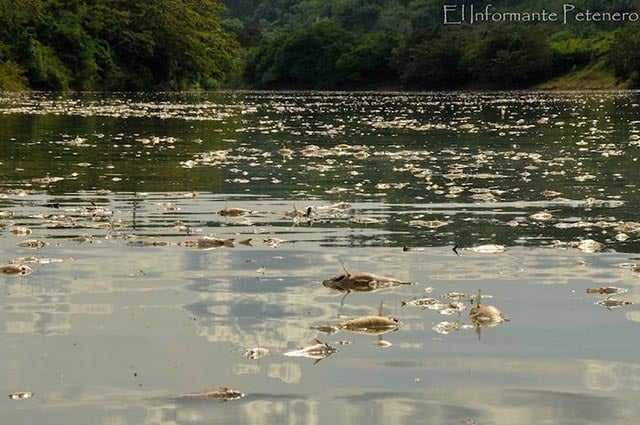 An estimated 100 miles of the La Pasión River were affected by the mass fish die-off, out of its total 200 miles. (Photo courtesy of El Informante Petenero)
An estimated 100 miles of the La Pasión River were affected by the mass fish die-off, out of its total 200 miles. (Photo courtesy of El Informante Petenero)
The June incident was the second of its kind in less than five weeks. Communities in Sayaxché reported a much smaller-scale fish die-off in the La Pasión River that began at the end of April, but it drew relatively little national attention or investigation. MARN officials later revealed that the agency received a letter on May 4 from REPSA representatives detailing how heavy rains on April 28 caused an effluent pond to overflow into one of the waterways that feeds the La Pasión River.
The incident that began on June 6, however, captured national and international media attention and prompted government action. For days, the surface of the river was awash with dead fish and other aquatic life for 100 miles. At least 23 species were among the dead. Government officials estimated 12,000 people were directly affected. Many communities in Sayaxché depend on the river for drinking water, bathing, washing, and fish.
Reports prematurely citing pesticide as the cause of the June fish die-off began to circulate. A university study conducted after the previous incident had detected the presence of malathion in water samples taken from the La Pasión River. The organophosphate insecticide is widely used in agriculture, and is highly toxic to some freshwater fish. REPSA stated that the company does not use malathion and denied responsibility.
“Apparently there was malathion in the river, but that’s not what caused the die-off,” CONAP spokesperson José Pablo Coyoy told Mongabay.
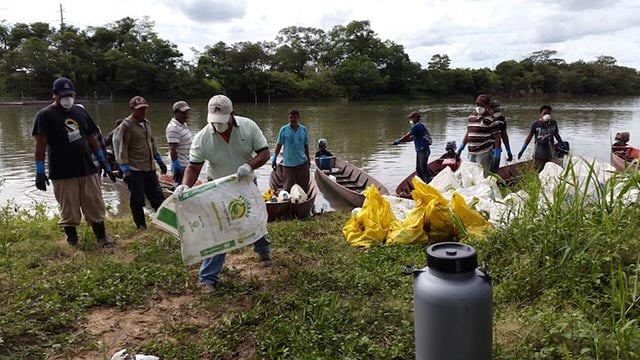 At least 23 species of fish and other aquatic life were among the dead specimens collected from the La Pasión River, according to Guatemalan government authorities. (Photo courtesy of El Informante Petenero)
At least 23 species of fish and other aquatic life were among the dead specimens collected from the La Pasión River, according to Guatemalan government authorities. (Photo courtesy of El Informante Petenero)
Scientists and government officials now suspect that both die-offs were caused by massive overflows of organic matter from palm-oil mill effluent ponds into the river. The high oxygen demand of the decaying organic matter could result in the asphyxiation of fish and other aquatic life below the surface.
“For that to happen, they would need to be huge quantities,” said Coyoy. “That’s exactly the investigation that the Office of the Public Prosecutor must carry out to establish what the cause was and who may have been responsible,” he said.
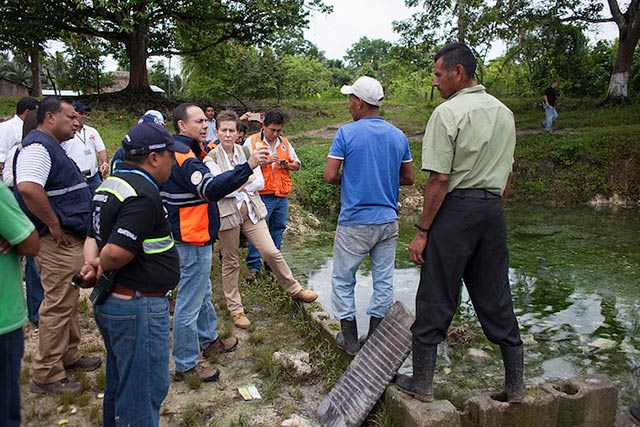 Officials with the Guatemalan government and the UN speak with Sayaxché residents affected by the contamination of the La Pasión River. (Photo by CONRED Guatemala)
Officials with the Guatemalan government and the UN speak with Sayaxché residents affected by the contamination of the La Pasión River. (Photo by CONRED Guatemala)
CONAP is intervening as a joint plaintiff in the case against REPSA, alongside the Office of the Public Prosecutor. “CONAP got involved mainly because of biological diversity, because obviously there was an impact on all the life that was there, not just in the river but in the surroundings,” said Coyoy. The agency is responsible for the country’s biodiversity as well as its protected areas, and the Petén department is rich in both.
The Petén department covers the northern third of the country’s land mass. Wedged between Mexico and Belize, it is home to iconic species such as the jaguar (Panthera onca), endangered Baird’s tapir (Tapirus bairdii), and scarlet macaw (Ara macao). The Maya Biosphere Reserve covering the northern half of the department includes a vast swatch of tropical rainforest. In southern Petén, the 200-mile-long La Pasión River meanders west from Sayaxché to the Mexican border where it flows into the Usumacinta River, which then heads north through protected areas and important wetlands before draining into the Gulf of Mexico.
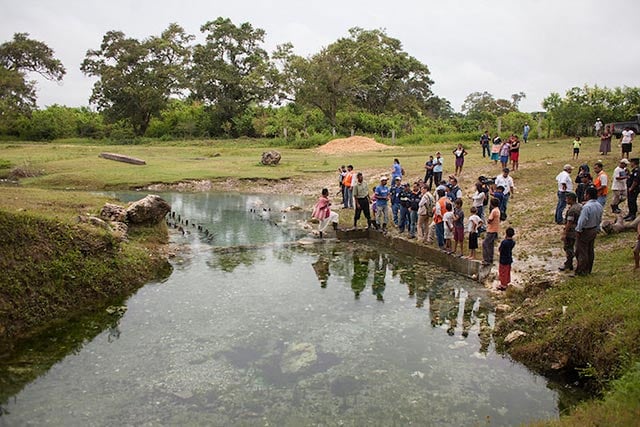 Sayaxché residents gather by a stream during a visit in July by Guatemalan government and UN officials to communities affected by the mass fish die-off in June. (Photo by CONRED Guatemala)
Sayaxché residents gather by a stream during a visit in July by Guatemalan government and UN officials to communities affected by the mass fish die-off in June. (Photo by CONRED Guatemala)
The La Pasión River is a key source of water and fish for Sayaxché residents, where three quarters of the population live in poverty. At least two thirds of the 100,000 municipal residents are indigenous. Most are Maya Q’eqchi’, and many were displaced during the 1960-1996 armed conflict in which an estimated 200,000 civilians were killed.
Sayaxché residents reacted swiftly to the mass fish die-off in the La Pasión river. The municipal government called a meeting on June 11 to address the situation. Representatives from community development councils, deputy village mayors, CONDEG, and other groups and institutions active in Sayaxché – 180 people in total – all attended the meeting. They appointed local professionals and community leaders to represent them, forming the Commission for the Defense of Life and Nature.
The commission’s initial responsibilities were twofold, according to Saúl Pauu, a longtime local Maya Q’eqchi’ community leader and member of the commission.
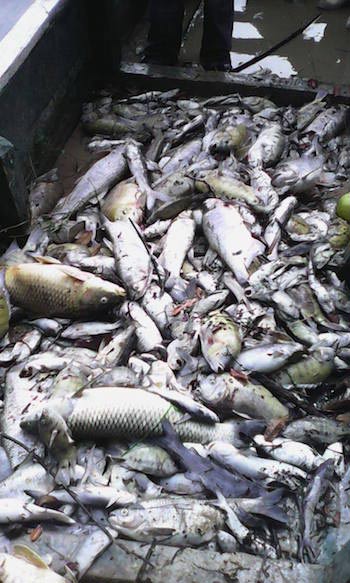 An estimated 100 miles of the La Pasión River were affected by the mass fish die-off, out of its total 200 miles. (Photo courtesy of El Informante Petenero)“The first thing was the idea of legal action against the company, which is who carried out the problem of the ecocide. For that reason, the Commission for the Defense of Life and Nature proposed a criminal case against REPSA,” Pauu told Mongabay.
An estimated 100 miles of the La Pasión River were affected by the mass fish die-off, out of its total 200 miles. (Photo courtesy of El Informante Petenero)“The first thing was the idea of legal action against the company, which is who carried out the problem of the ecocide. For that reason, the Commission for the Defense of Life and Nature proposed a criminal case against REPSA,” Pauu told Mongabay.
However, the commission was also faced with the immediate impacts on thousands of local residents, many of whom were left without water. “So we started to act so that the state of Guatemala would comply with humanitarian assistance to the communities,” said Pauu. The commission has since gone on to fulfil another key role, he said – that of keeping residents informed of new developments.
Ongoing threats
In light of the violence on September 18, Pauu is concerned the already tense situation in Sayaxché will escalate. Private security agents in uniform working for REPSA and other men armed with high caliber weapons were present during the illegal detention of Asij, Mendoza, and Pérez, he said, adding that threats against community leaders are ongoing. As a result, community residents are outraged, terrified, and divided, he said.
“The conflict could heat up,” said Pauu. “I would even dare to say that there could be an explosion of social unrest if the state doesn’t take action.”
Environmental conflicts and attacks against environmental activists around the country have remained constant in recent years, according to Carlos Fernández, sub coordinator of the non-governmental organization, the Guatemalan Human Rights Defenders Protection Unit (UDEFEGUA). He said that as long as oil palm, mining, and other natural-resource-intensive projects continue to advance without taking communities into consideration, he doesn’t anticipate any improvement.
“There is usually no dialogue with communities. There is no community consultation,” Fernández told Mongabay. “The only way companies and even the state sustain these projects is imposition, and that always entails violence against environmental defenders.”
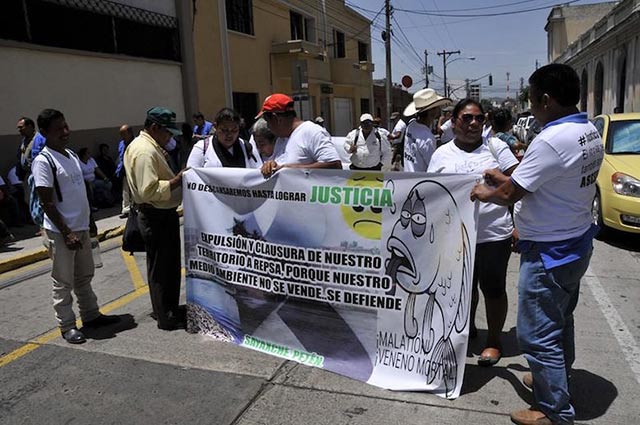 Sayaxché community residents have staged rallies, marches, and road blockades to protest the ecological disaster and the REPSA oil palm company suspected of being responsible for it. “We Will Not Rest Until We Achieve JUSTICE,” reads a banner at a rally in June. (Photo courtesy of El Informante Petenero)
Sayaxché community residents have staged rallies, marches, and road blockades to protest the ecological disaster and the REPSA oil palm company suspected of being responsible for it. “We Will Not Rest Until We Achieve JUSTICE,” reads a banner at a rally in June. (Photo courtesy of El Informante Petenero)
Sayaxché residents continue to demand justice for the murder of Lima Choc, which remains under investigation. They also continue to demand answers and justice for the ecological disaster on the La Pasión River.
The court-ordered suspension of REPSA’s operations is for up to six months, but the company has filed an appeal for the reversal of the decision. A key turning point in the judicial investigation into the June mass fish die-off – as well as the tense situation in Sayaxché – will come on October 7. That’s when Judge Hernández will consider REPSA’s appeal in the presence of all parties, according to Rafael Maldonado, an environmental lawyer with the Center for Environmental and Social Legal Action (CALAS), another of the joint plaintiffs intervening alongside the Office of the Public Prosecutor in the proceedings against REPSA.
“The decision was in accordance with the law, well grounded in the framework of Guatemalan national environmental legislation,” Maldonado told Mongabay. “We hope the judge confirms it at the hearing.”
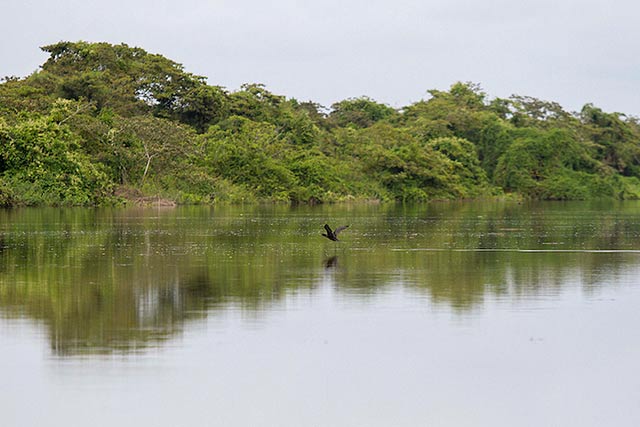 The La Pasión River, a month after the mass fish die-off. (Photo by CONRED Guatemala)
The La Pasión River, a month after the mass fish die-off. (Photo by CONRED Guatemala)
Join us in defending the truth before it’s too late
The future of independent journalism is uncertain, and the consequences of losing it are too grave to ignore. We have hours left to raise the $12,0000 still needed to ensure Truthout remains safe, strong, and free. Every dollar raised goes directly toward the costs of producing news you can trust.
Please give what you can — because by supporting us with a tax-deductible donation, you’re not just preserving a source of news, you’re helping to safeguard what’s left of our democracy.